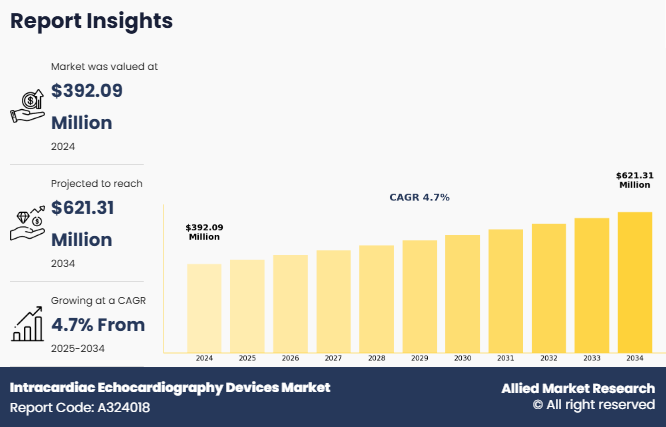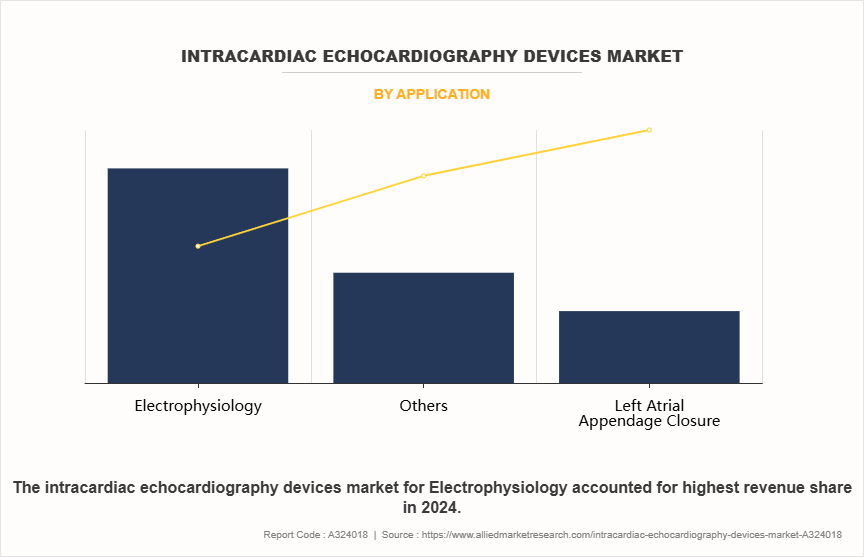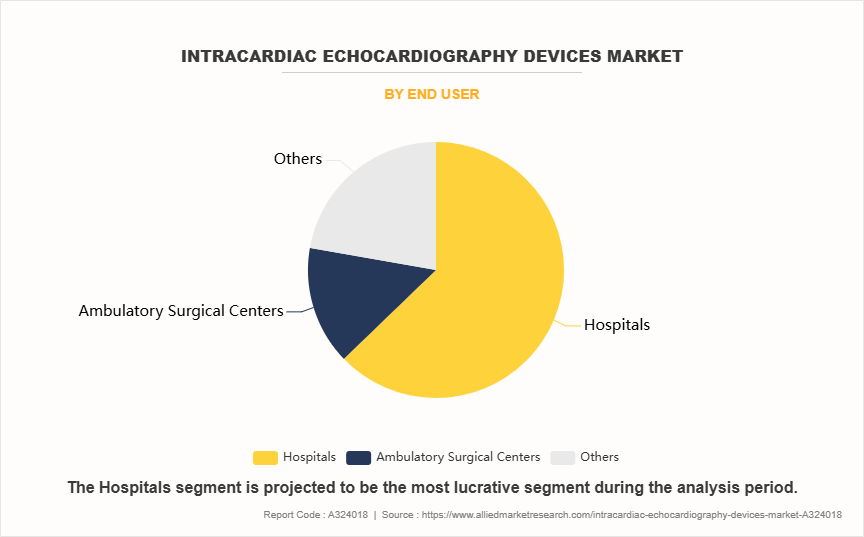Intracardiac Echocardiography Devices Market Research, 2034
The global intracardiac echocardiography devices market was valued at $392.1 million in 2024, and is projected to reach $621.3 million by 2034, growing at a CAGR of 4.7% from 2025 to 2034. The growth of the intracardiac echocardiography devices (ICE) market is driven by an increase in prevalence of cardiovascular diseases and rise in adoption of minimally invasive cardiac procedures. According to the American Heart Association, by 2050, the prevalence of cardiovascular disease in the U.S. is projected to rise from 11.3% to 15% of the population, potentially affecting up to 45 million adults.
In addition, an article published by the National Center for Biotechnology Information (NCBI) in 2024, the prevalence of atrial fibrillation (AF) is projected to rise to 15.9 million in the America by 2050 and to 17.9 million in Europe by 2060. This rise in prevalence necessitates advanced imaging tools, thereby supporting the demand for ICE devices.

Intracardiac echocardiography devices are advanced medical imaging tools used to obtain high-resolution, real-time images of the heart and surrounding structures from within the heart chambers. These catheter-based ultrasound devices are inserted through a vein and guided to the heart, where they provide detailed visualization during interventional cardiac procedures such as ablations, transseptal punctures, and left atrial appendage closures. ICE devices enhance procedural accuracy, reduce the need for fluoroscopy, and minimize patient exposure to radiation. Their precision and ability to provide immediate feedback make them highly valuable in guiding complex electrophysiological and structural heart interventions.
Key Takeaways
- On the basis of product, the catheter segment dominated the global intracardiac echocardiography devices market size in 2024.
- On the basis of application, the electrophysiology segment dominated the global market in 2024. However, the injectable segment is anticipated to be the fastest-growing segment during the forecast period.
- On the basis of end user, the hospitals segment dominated the global intracardiac echocardiography devices market share in terms of revenue in 2024.
- North America dominated the market in terms of revenue in 2024. However, Asia-Pacific is anticipated to grow at the highest CAGR during the forecast period.
Market Dynamics
The global intracardiac echocardiography devices market growth is primarily driven by rise in incidence of cardiovascular diseases, growth in preference for minimally invasive procedures, and increase in the adoption of advanced imaging techniques in interventional cardiology. As heart-related ailments continue to be the leading cause of mortality worldwide, healthcare systems are increasingly adopting precision diagnostics to support early detection and effective management of cardiac conditions.
In addition, the aging population, who are more prone to cardiac disorders, is increasing the demand for efficient, safer diagnostic methods, further fueling market expansion. For elderly patients, who are generally at higher surgical risk, ICE-guided procedures such as transcatheter ablation, left atrial appendage closure, and transcatheter valve repair or replacement offer safer, more precise, and less invasive solutions. This led to increased adoption of ICE, particularly in developed healthcare systems where the elderly demographic is expanding rapidly, thereby driving intracardiac echocardiography devices market forecast.
ICE devices, which provide high-resolution, real-time images of the heart from within, have become crucial tools in complex procedures such as transcatheter aortic valve implantation (TAVI), atrial fibrillation ablation, and congenital heart defect repairs. The shift from traditional imaging modalities like transesophageal echocardiography (TEE) to ICE is also accelerating due to the latter's ability to offer detailed visualization without requiring general anesthesia or esophageal intubation, thereby reducing procedure time and improving patient comfort, thereby driving intracardiac echocardiography devices market outlook.
The supportive government policies, growth in investments in healthcare infrastructure, and an expanding base of skilled interventional cardiologists are expected to lead to long-term market growth. With continued innovation, strategic collaborations among medical device companies, and growing awareness among clinicians regarding the clinical advantages of ICE are expected to experience robust growth in the coming years.
In addition, the trend toward outpatient cardiac procedures, driven by the need to reduce hospital stays and healthcare costs, aligns well with the advantages offered by ICE devices. Overall, the convergence of clinical necessity, technological progress, and healthcare system evolution is propelling the intracardiac echocardiography devices market forward, positioning it for significant intracardiac echocardiography devices market opportunity in the coming years.
However, the high cost associated with ICE devices and the related procedures, which can limit adoption, especially in low- and middle-income countries with constrained healthcare budgets, thereby restricts the market growth. The need for specialized training and expertise to operate these sophisticated imaging systems further restricts widespread usage, as many healthcare facilities lack adequately trained personnel.
On the other hand, the market simultaneously holds substantial opportunities that can counterbalance these challenges. Growing prevalence of cardiovascular diseases worldwide, including atrial fibrillation and structural heart defects, is driving demand for precise and real-time cardiac imaging, where ICE devices play a crucial role. The rise of minimally invasive cardiac procedures such as catheter ablations and transcatheter valve replacements has increased reliance on ICE to guide these interventions safely and effectively.
Moreover, technological advancements, including the development of 3D and 4D intracardiac imaging and integration with advanced electro anatomical mapping systems, are expanding clinical applications and improving the ease of use of ICE devices. Furthermore, increasing healthcare investments and improving cardiac care infrastructure in emerging markets such as Asia-Pacific and LAMEA present significant growth potential. Government initiatives promoting early diagnosis and treatment of heart diseases are expected to increase adoption rates in these regions.
Segmental Overview
The intracardiac echocardiography devices market is segmented on the basis of product, application, end user, and region. By product, the market is classified into ultrasound system, catheter, and others. By application, the market is segmented into electrophysiology, left atrial appendage closure, and others. By end user, the market is classified into hospitals, ambulatory surgical centers, and others.
Region-wise, the market is analyzed across North America (the U.S., Canada, and Mexico), Europe (Germany, France, the UK, Italy, Spain, and rest of Europe), Asia-Pacific (China, Japan, Australia, India, South Korea, and rest of Asia-Pacific), and LAMEA (Brazil, South Africa, Saudi Arabia, and rest of LAMEA).
By Product
The catheter segment dominated the intracardiac echo devices market share in 2024 and is expected to register the highest CAGR during the forecast period. This is attributed to its essential role in delivering precise, real-time cardiac imaging during minimally invasive procedures. Catheters offer superior maneuverability and access to complex cardiac structures, enhancing the accuracy of interventions such as atrial fibrillation ablation and structural heart repairs.
Advances in catheter technology, intracardiac imaging including the development of 3D and high-definition imaging catheters, are improving image quality and procedural outcomes. In addition, increasing adoption of catheter-based cardiac therapies and the growing preference for less invasive diagnostic methods support the segment’s strong growth prospects. The ability to integrate with mapping systems further increases the clinical utility of catheter-based ICE devices, driving segment growth.

By Application
The electrophysiology segment dominated the intracardiac echocardiography devices industry share in 2024 and is expected to register the highest CAGR during the forecast period. This is attributed to the increase in prevalence of arrhythmias and the growing adoption of catheter ablation procedures. The use of intracardiac echocardiography in electrophysiology enhances procedural safety and precision by providing real-time visualization of cardiac anatomy. In addition, advancements in 3D mapping technologies and the rising demand for minimally invasive cardiac diagnostics are driving the sustained growth of the segment.

By End User
The hospitals segment dominated the intracardiac echocardiography devices market share in 2024 and is expected to register the highest CAGR during the forecast period. This is attributed to the availability of advanced cardiac care facilities and a higher volume of complex cardiac procedures performed in these settings. Hospitals offer comprehensive diagnostic and interventional services, attracting more patients requiring intracardiac imaging. In addition, increased investments in healthcare infrastructure and skilled cardiology professionals in hospitals contribute to the growing adoption of ICE devices.

By Region
The intracardiac echocardiography devices market is analyzed across North America, Europe, Asia-Pacific, and LAMEA. North America dominated the intracardiac echocardiography devices market share in terms of revenue in 2024. The growth in this region is attributed to well-established healthcare infrastructure, prevalence of cardiovascular diseases, and widespread adoption of advanced medical technologies. In addition, strong government support for cardiac care, significant investments in research and development, and the presence of key market players driving innovation have further fueled market expansion in North America.
Asia-Pacific is expected to grow at the highest rate during the forecast period. This is attributed to increase in cases of cardiovascular diseases, rise in healthcare expenditure, and improved access to advanced medical technologies. Growing awareness about minimally invasive cardiac procedures, expanding healthcare infrastructure, and government initiatives to enhance cardiac care services in emerging economies like China and India are also driving market growth in the region. India and China are witnessing a surge in minimally invasive cardiac procedures due to growing patient populations and improved access to healthcare services. The aging global population also contributes to market expansion, as older adults are more susceptible to cardiac conditions requiring ICE-guided interventions.

Competition Analysis
Key players such as Koninklijke Philips N.V. and Fujifilm Corporation have adopted product launch, partnership, and expansion as key developmental strategies to improve the product portfolio of the intracardiac echocardiography devices market. For instance, in May 2024, Royal Philips, a global leader in health technology announced that the first hospitals in Hong Kong have started using Philips real-time 3D Intracardiac Echocardiography (ICE) catheter VeriSight Pro to aid minimally invasive image-guided procedures.
Recent Developments in Intracardiac Echocardiography Devices Industry
In April 2024, FUJIFILM Healthcare Americas Corporation announced the launch of its OPIE Transducer for on-pump intracardiac echocardiography (OPIE) for septal myectomy.
In March 2024, FUJIFILM Healthcare Americas Corporation, a leading provider of diagnostic and enterprise imaging solutions and Us2.ai, a leader in AI-automated echocardiography solutions, have partnered to equip Fujifilm’s LISENDO 800 cardiovascular ultrasound system with Us2.ai’s artificial intelligence (AI)-driven, automated clinical workflow solution.
In August 2024, Siemens Healthineers announced the Food and Drug Administration (FDA) clearance of the ACUSON Origin, a new dedicated cardiovascular ultrasound system powered by artificial intelligence (AI) features. These features can help physicians perform cardiac procedures more efficiently in the areas of diagnostics, structural heart disease, and electrophysiology. Available exclusively with the ACUSON Origin, the new AcuNav Lumos 4D ICE (intracardiac echocardiography) catheter provides advanced imaging for complex heart procedures.
In February 2023, GE HealthCare, announced that it has signed an agreement to acquire Caption Health, Inc., a privately owned artificial intelligence (AI) healthcare leader that creates clinical applications to aid in early disease detection, using AI to assist in conducting ultrasound scans. With Caption AI applications, ultrasound examinations can be easier and faster, enabling a broader set of healthcare professionals to conduct basic echocardiogram exams.
Key Benefits For Stakeholders
- This report provides a quantitative analysis of the market segments, current trends, estimations, and dynamics of the intracardiac echocardiography devices market analysis from 2024 to 2034 to identify the prevailing intracardiac echocardiography devices market opportunities.
- The market research is offered along with information related to key drivers, restraints, and opportunities.
- Porter's five forces analysis highlights the potency of buyers and suppliers to enable stakeholders make profit-oriented business decisions and strengthen their supplier-buyer network.
- In-depth analysis of the intracardiac echocardiography devices market segmentation assists to determine the prevailing market opportunities.
- Major countries in each region are mapped according to their revenue contribution to the global market.
- Market player positioning facilitates benchmarking and provides a clear understanding of the present position of the market players.
- The report includes the analysis of the regional as well as global intracardiac echocardiography devices market trends, key players, market segments, application areas, and market growth strategies.
Intracardiac Echocardiography Devices Market, by Product Report Highlights
| Aspects | Details |
| Market Size By 2034 | USD 621.3 million |
| Growth Rate | CAGR of 4.7% |
| Forecast period | 2024 - 2034 |
| Report Pages | 361 |
| By Product |
|
| By Application |
|
| By End User |
|
| By Region |
|
| Key Market Players | Terumo Corporation, GE HealthCare, Koninklijke Philips N.V., Siemens AG, Fujifilm Corporation, Medtronic plc, Boston Scientific Corporation, Abbott Laboratories, Shenzhen Mindray Bio-Medical Electronics Co., Ltd, Johnson & Johnson |
Analyst Review
This section provides various opinions of top-level CXOs in the global intracardiac echocardiography devices market. According to the insights of CXOs, the global intracardiac echocardiography devices market is expected to exhibit high growth potential attributable to the increase in prevalence of cardiovascular diseases, rise in demand for minimally invasive procedures, and advancements in imaging technologies.
CXOs further added growing adoption of ICE for real-time imaging during complex cardiac procedures and favorable government initiatives for healthcare improvements are driving market expansion.
Furthermore, North America dominated the market share, in terms of revenue in 2024, owing to the presence of well-established healthcare infrastructure, high healthcare spending, and a growing number of cardiac procedures requiring advanced imaging technologies. However, Asia-Pacific is anticipated to witness notable growth owing to the rise in prevalence of cardiovascular diseases, increasing healthcare investments, and expanding access to advanced medical technologies.
The total market value of intracardiac echocardiography devices market was $392.09 million in 2024.
The forecast period for intracardiac echocardiography devices market is 2025 to 2034.
The market value of intracardiac echocardiography devices market is projected to reach $621.31 million by 2034.
The growth of the intracardiac echocardiography devices market is driven by the rising prevalence of cardiovascular diseases, increasing adoption of minimally invasive cardiac procedures, and advancements in imaging technologies such as 3D and 4D ICE.
The base year is 2024 in intracardiac echocardiography devices market .
Intracardiac echocardiography (ICE) devices are specialized medical imaging tools used to provide real-time, high-resolution ultrasound images of the heart from within its chambers. These devices typically consist of catheter-based ultrasound probes that are inserted into the heart via blood vessels, allowing clinicians to visualize cardiac structures during diagnostic and interventional procedures.
The Asia-Pacific region is witnessing the fastest growth in the intracardiac echocardiography devices market. This rapid expansion is driven by several factors, including rising healthcare expenditures, increasing prevalence of cardiovascular diseases, and significant investments in medical infrastructure.
Loading Table Of Content...
Loading Research Methodology...



